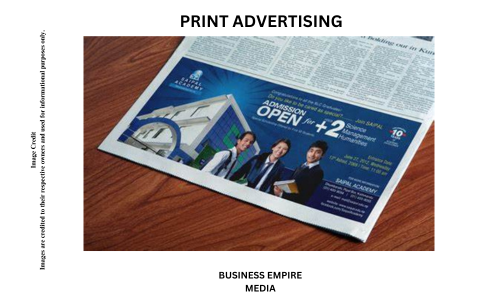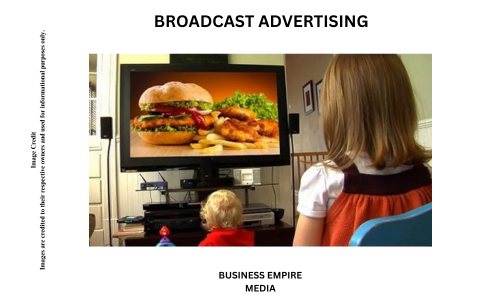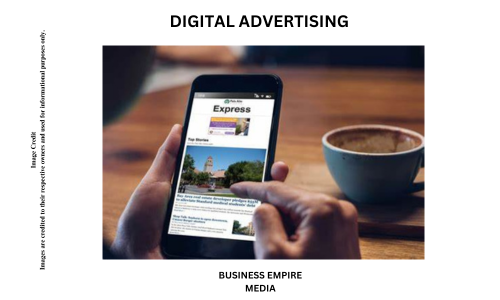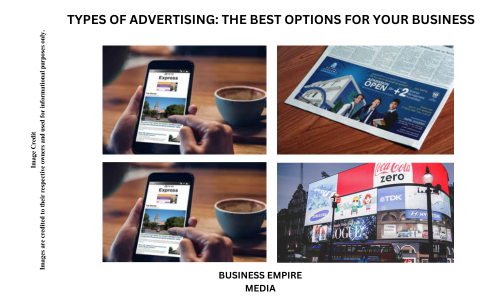In today’s fast-paced and competitive market, advertising is crucial for businesses to connect with their audience and drive sales. However, with so many different advertising types available, choosing the right one for your business can be overwhelming. This blog will explore the various types of advertising, helping you understand their unique benefits and how to utilize them in your marketing strategy effectively.
Here are 15 different Types of Advertising
1. Print Advertising

Introduction:
Print advertising refers to the use of physical media, such as newspapers, magazines, brochures, and flyers, to promote products, services, or brands. Despite the growing dominance of digital platforms, print advertising continues to play a significant role in reaching specific audiences, especially those who prefer tangible, offline content. It offers a classic and often high-quality way to engage with consumers.
Pros:
- Tangible Format: Print ads provide a physical product that can be held, read, and revisited, creating a lasting impression.
- Enhanced Credibility: Print media is frequently viewed as more credible and authoritative compared to digital alternatives.
- Effective Local Targeting: Print advertising can effectively target local audiences through community newspapers and regional magazines.
- Less Digital Distraction: Print ads are not subject to the same level of digital clutter as online ads, which can enhance their visibility and impact.
Cons:
- Higher Costs: The expenses associated with designing, printing, and distributing print ads can be significant, particularly for high-quality placements.
- Limited Reach: The audience is restricted to the circulation of the publication, which may not reach as broad an audience as digital channels.
- Measurement Difficulties: Gauging the effectiveness of print advertising can be challenging, often relying on indirect metrics like coupon redemption or surveys.
- Declining Engagement: With the rise of digital media, print readership is decreasing, potentially diminishing the effectiveness of print ads over time.
2. Broadcast Advertising

Introduction:
Broadcast advertising encompasses television and radio commercials designed to reach a wide audience through audio-visual or audio channels. This form of advertising leverages the broad reach of broadcast media to deliver messages to large, diverse audiences. With its ability to combine sound, imagery, and motion, broadcast advertising aims to capture attention and generate a significant impact.
Pros:
- Wide Reach: Broadcast advertising can reach a vast audience, including different demographics and geographic locations, through TV and radio.
- High Impact: The combination of audio and visual elements in TV ads, or the strong auditory appeal of radio ads, can create memorable and persuasive messages.
- Brand Awareness: Effective for building brand recognition and establishing a strong presence in the market.
- Scheduled Programming: Ads can be placed during popular shows or peak listening times to maximize visibility and impact.
Cons:
- High Costs: Production and airtime costs for TV and radio ads can be expensive, making it a significant investment for many businesses.
- Limited Targeting: While broadcast ads reach a broad audience, they lack the precise targeting capabilities of digital advertising.
- Measuring Effectiveness: Tracking the exact impact of broadcast ads can be challenging, often relying on general metrics like audience ratings and surveys.
- Ad Skipping: With DVR and streaming services, TV viewers can skip ads, and radio listeners may change stations, reducing ad exposure
3. Digital Advertising

Introduction:
Digital advertising utilizes online platforms such as search engines, social media, websites, and mobile apps to promote products or services. It encompasses various formats including display ads, search engine ads, social media ads, and video ads. Digital advertising offers targeted, measurable, and interactive opportunities for businesses to reach audiences in a highly personalized and dynamic way.
Pros:
- Precise Targeting: Digital ads can be highly targeted based on demographics, interests, behavior, and location, allowing for tailored messaging to specific audience segments.
- Measurable Results: Digital advertising provides detailed analytics and metrics, enabling businesses to track performance, measure ROI, and make data-driven decisions.
- Cost-Effective: Digital advertising offers flexibility in budgeting, with options to scale spending up or down based on performance and objectives.
- Interactive and Engaging: Formats such as video ads, interactive banners, and social media campaigns can engage users more effectively than traditional media.
Cons:
- Ad Fatigue: High competition and frequent exposure can lead to ad fatigue, where users become desensitized to advertising messages.
- Privacy Concerns: The collection of user data for targeting purposes can raise privacy issues and concerns among consumers.
- Ad Blocking: Many users employ ad-blocking software to avoid digital ads, which can reduce the effectiveness of campaigns.
- Complexity: The digital advertising landscape is rapidly evolving, requiring ongoing learning and adaptation to keep up with new technologies, platforms, and best practices.
4. Outdoor Advertising
Introduction:
Outdoor advertising, also known as out-of-home (OOH) advertising, involves placing ads in public spaces such as billboards, transit ads, posters, and digital screens. This form of advertising aims to reach a wide audience through high-visibility locations and is often used to reinforce brand messages or promote local events. Outdoor advertising offers constant exposure and can effectively capture the attention of people on the go.
Pros:
- High Visibility: Outdoor ads are placed in high-traffic areas, ensuring significant exposure and visibility to a large audience.
- Continuous Exposure: Ads are visible 24/7, providing ongoing exposure and reinforcing brand messages over time.
- Local Targeting: Effective for targeting specific geographic areas and local markets, especially with transit ads and localized billboards.
- Creative Impact: Large formats and creative designs can create strong visual impressions and enhance brand recognition.
Cons:
- High Costs: Prime locations and large-scale ads can be expensive to produce and place, making it a considerable investment.
- Limited Interaction: Outdoor ads typically lack interactive elements, limiting opportunities for direct engagement with the audience.
- Measurement Challenges: Tracking the effectiveness of outdoor ads can be difficult, often relying on estimates of traffic and visibility rather than precise metrics.
- Environmental Factors: Outdoor ads are exposed to weather conditions and environmental elements, which can impact their appearance and effectiveness over time.
5. Direct Mail Advertising
Introduction:
Direct mail advertising involves sending promotional materials, such as postcards, brochures, catalogs, or letters, directly to a targeted audience through postal services. This form of advertising aims to engage recipients with personalized offers and information. Direct mail is often used to reach potential customers with specific, actionable messages, leveraging a physical touchpoint to capture attention.
Pros:
- Personalization: Direct mail allows for highly personalized communication, targeting specific demographics or individual preferences based on data.
- Tangible Impact: As a physical item, direct mail can make a lasting impression and often receives higher engagement than digital ads.
- Targeted Reach: Businesses can target specific geographic areas or demographics, increasing the relevance of the message to the recipient.
- Trackable Responses: Direct mail campaigns can include tracking mechanisms, such as unique codes or URLs, to measure response rates and effectiveness.
Cons:
- Cost: Direct mail can be expensive, considering the costs of design, printing, and postage, especially for large-scale campaigns.
- Environmental Concerns: The use of paper and postal services can raise environmental concerns and contribute to waste if not managed responsibly.
- Potential for Low Engagement: Direct mail may be perceived as junk mail or discarded without being read, especially if not well-targeted or relevant.
- Limited Interaction: Unlike digital advertising, direct mail lacks interactive elements, reducing opportunities for real-time engagement with the audience.
6. Influencer Marketing
Introduction:
Influencer marketing involves collaborating with individuals who have a significant following and influence on social media or other digital platforms to promote products, services, or brands. These influencers, who can range from celebrities to niche content creators, leverage their credibility and reach to engage their audience and drive brand awareness or sales.
Pros:
- Targeted Reach: Influencers often have dedicated followings within specific niches, allowing brands to target specific demographics or interest groups effectively.
- Credibility and Trust: Influencers typically have established trust with their audience, making their endorsements more credible and persuasive than traditional advertising.
- Engagement: Influencer content often generates high levels of engagement, including likes, comments, and shares, which can amplify brand messages.
- Cost Flexibility: There are options for various budgets, from working with micro-influencers to high-profile celebrities, allowing for tailored campaigns.
Cons:
- Cost Variability: High-profile influencers can command significant fees, making it expensive for some brands to collaborate with top-tier personalities.
- Authenticity Risks: There is a risk that influencers may not genuinely use or believe in the products they promote, which can affect credibility and audience trust.
- Dependence on Influencer’s Reputation: The brand’s image can be impacted by the influencer’s behavior or controversies, potentially affecting the campaign’s success.
- Measurement Challenges: Assessing the true impact and ROI of influencer campaigns can be difficult, as it involves tracking metrics such as engagement, conversions, and overall influence.
7. Content Marketing
Introduction:
Content marketing is a strategic approach focused on creating and distributing valuable, relevant, and consistent content to attract and engage a clearly defined audience. The goal is to drive profitable customer action by providing informative, entertaining, or educational content that addresses the needs and interests of the target audience. This can include blog posts, articles, videos, infographics, and social media updates.
Pros:
- Builds Authority: By providing valuable and informative content, brands can establish themselves as industry leaders and build trust with their audience.
- Increases Engagement: High-quality content can attract and engage potential customers, fostering a deeper connection and encouraging interactions.
- Supports SEO: Well-optimized content can improve search engine rankings, driving organic traffic to the brand’s website.
- Cost-Effective: Compared to traditional advertising, content marketing can be more cost-effective, especially if created in-house, and can provide long-term benefits through evergreen content.
Cons:
- Time-Consuming: Creating high-quality, relevant content requires significant time and effort, often necessitating ongoing content development and strategy adjustments.
- Delayed Results: Content marketing may not yield immediate results and requires a sustained effort to see significant impact on brand awareness and lead generation.
- Resource Intensive: Effective content marketing requires resources for content creation, distribution, and management, which can be challenging for smaller businesses.
- Competition: The content landscape is highly competitive, making it difficult to stand out and capture the audience’s attention amid a vast amount of content.
8. Email Marketing
Introduction:
Email marketing involves sending promotional messages, updates, or newsletters directly to a list of subscribers via email. It is a direct way to communicate with potential and existing customers, aiming to drive engagement, inform about new products or services, and foster customer loyalty. Email marketing is often used to nurture leads, promote offers, and build relationships with the audience.
Pros:
- Cost-Effective: Email marketing is relatively inexpensive compared to other advertising methods, with low costs for creating and sending emails.
- Targeted Messaging: Emails can be highly personalized and segmented based on user behavior, preferences, and demographics, enhancing relevance and effectiveness.
- Measurable Results: Detailed metrics such as open rates, click-through rates, and conversion rates provide clear insights into campaign performance and ROI.
- Automation Capabilities: Email marketing platforms offer automation features for scheduling, follow-ups, and drip campaigns, streamlining the process and saving time.
Cons:
- Spam Concerns: Emails may be marked as spam or ignored if not well-targeted or if recipients feel overwhelmed by excessive communication.
- Deliverability Issues: Factors such as email content, sender reputation, and user engagement can affect whether emails reach the inbox or get filtered out.
- Design Limitations: Designing visually appealing and responsive emails can be challenging, especially when accommodating various devices and email clients.
- Privacy Regulations: Compliance with privacy laws and regulations (e.g., GDPR, CAN-SPAM) requires careful management of subscriber data and consent, adding complexity to email marketing efforts
9. Guerrilla Advertising
Introduction:
Guerrilla advertising is an unconventional marketing strategy that aims to create memorable, impactful brand experiences using low-budget, creative tactics. It often involves surprising or engaging the public in unexpected ways, such as through street art, flash mobs, or interactive installations. The goal is to generate buzz and word-of-mouth promotion by capturing attention and creating a strong emotional response.
Pros:
- High Impact: Guerrilla advertising can create a significant buzz and generate widespread media coverage and social media engagement due to its innovative and surprising nature.
- Cost-Effective: Compared to traditional advertising methods, guerrilla campaigns often require lower budgets and can achieve substantial results with minimal investment.
- Memorable Experiences: The unique and creative approach of guerrilla advertising helps to make a lasting impression on the audience, increasing brand recall.
- Viral Potential: Well-executed guerrilla campaigns have the potential to go viral, reaching a larger audience through shares and discussions online.
Cons:
- Risk of Misinterpretation: The unconventional nature of guerrilla advertising can sometimes lead to misinterpretation or backlash if the campaign is perceived as offensive or inappropriate.
- Limited Control: The success of a guerrilla campaign can be unpredictable, and there is less control over how the campaign will be received and spread.
- Short-Term Attention: Guerrilla advertising often provides a short burst of attention, which may not lead to sustained brand recognition or long-term engagement.
- Resource Intensive: While the financial cost may be low, guerrilla campaigns can be resource-intensive in terms of creativity, planning, and execution, requiring significant effort to ensure effectiveness.
10. Event Sponsorship
Introduction:
Event sponsorship involves supporting an event, such as conferences, sports events, festivals, or trade shows, in exchange for promotional opportunities. Sponsors typically provide financial support or in-kind contributions (e.g., products or services) and, in return, gain exposure through event branding, advertising, and access to attendees. This form of marketing helps brands align with specific events and engage with targeted audiences in a meaningful context.
Pros:
- Brand Visibility: Sponsoring an event provides significant exposure through event marketing materials, signage, and media coverage, helping to increase brand recognition.
- Targeted Audience: Events often attract specific demographics or interest groups, allowing sponsors to directly reach their target market in a relevant setting.
- Enhanced Brand Image: Associating with reputable or popular events can enhance a brand’s image and credibility, aligning it with positive experiences and causes.
- Networking Opportunities: Events offer opportunities to connect with potential customers, partners, and industry influencers, facilitating relationship building and business development.
Cons:
- High Costs: Sponsoring major events can be expensive, with costs related to sponsorship fees, promotional materials, and additional activities or engagements.
- Limited Control: Sponsors may have limited control over event execution and the overall attendee experience, which can impact how the brand is perceived.
- Uncertain ROI: Measuring the direct impact of sponsorship on brand awareness and sales can be challenging, as the results may not be immediately evident.
- Risk of Association: If the event experiences negative outcomes or controversies, the sponsor’s brand may also be affected by association, potentially impacting its reputation.
11. Podcast Advertising
Introduction:
Podcast advertising involves placing promotional messages or sponsorships within podcast episodes. This can include host-read ads, pre-roll, mid-roll, or post-roll placements, where the podcast host integrates the ad content into their episode. With the increasing popularity of podcasts and their dedicated audiences, podcast advertising provides a unique opportunity to reach engaged listeners in a personalized and intimate setting.
Pros:
- Targeted Audience: Podcasts often cater to specific niches and demographics, allowing advertisers to target audiences that closely align with their products or services.
- Engaged Listeners: Podcast audiences tend to be highly engaged and attentive, providing a receptive environment for advertising messages.
- Credibility and Trust: Host-read ads benefit from the host’s established relationship with listeners, enhancing the credibility and trustworthiness of the message.
- Flexible Formats: Advertisers can choose from various ad formats, including sponsorships, product placements, and endorsements, to suit their marketing goals.
Cons:
- Cost Variability: The cost of podcast advertising can vary widely depending on the podcast’s popularity, audience size, and ad placement, which may be a barrier for smaller budgets.
- Measurement Challenges: Tracking the effectiveness of podcast ads can be difficult, as metrics like downloads and listens may not fully capture engagement or conversion rates.
- Limited Visual Impact: Podcasts are audio-only, which can limit the ability to showcase visual elements or demonstrate products visually.
- Ad Saturation: As podcast advertising grows in popularity, there is a risk of ad saturation, where listeners may become desensitized or annoyed by frequent ad interruptions.
12. Cross-Promotion
Introduction:
Cross-promotion involves collaborating with other businesses, brands, or content creators to promote each other’s products, services, or content. This strategy leverages the existing audiences and networks of each party to expand reach and increase visibility. Cross-promotion can occur through various channels, including social media, email newsletters, joint events, or co-branded content.
Pros:
- Increased Reach: By tapping into the partner’s audience, businesses can extend their reach and attract new customers who may not have been exposed to their brand otherwise.
- Cost-Effective: Cross-promotion often involves sharing resources and efforts, making it a cost-effective marketing strategy compared to traditional advertising methods.
- Enhanced Credibility: Partnering with established brands or influencers can lend credibility and trust to your brand, as it is associated with reputable entities.
- Mutual Benefits: Both parties benefit from the increased exposure and potential customer base, creating a win-win situation that can strengthen business relationships.
Cons:
- Brand Alignment: Successful cross-promotion requires a good fit between brands or partners. Mismatched values or target audiences can lead to ineffective or counterproductive results.
- Shared Control: Collaboration means sharing control over the messaging and presentation, which can lead to conflicts or inconsistencies in brand representation.
- Dependency Risks: Relying on partners for promotion can create dependency, and any issues on their end (e.g., changes in their strategy or audience engagement) can affect your campaign’s success.
- Limited Reach: The effectiveness of cross-promotion is limited to the size and engagement of the partner’s audience, and there may be diminishing returns if the audiences overlap significantly.
13. Native Advertising
Introduction:
Native advertising involves creating promotional content that seamlessly integrates with the surrounding editorial content on a platform, appearing as a natural part of the user experience. Unlike traditional ads, native ads match the form, function, and style of the content around them, making them less intrusive and more engaging. They can take various forms, including sponsored articles, videos, or social media posts.
Pros:
- Enhanced Engagement: Native ads blend with the content, making them less disruptive and more likely to capture the audience’s attention and engagement.
- Increased Credibility: By aligning with the platform’s content, native ads can benefit from the perceived credibility and trust of the editorial environment.
- Better User Experience: Native ads provide a less intrusive ad experience compared to traditional banner ads, which can lead to higher user satisfaction and interaction.
- Higher Click-Through Rates: The seamless integration of native ads often results in better click-through rates and conversion rates compared to more traditional ad formats.
Cons:
- Potential for Deception: If not clearly labeled, native ads can be mistaken for genuine editorial content, which may lead to accusations of misleading or deceptive advertising practices.
- Cost: Developing high-quality native ads that fit well with editorial content can be more expensive than traditional ad formats due to the need for custom creation and strategic placement.
- Measurement Challenges: Assessing the effectiveness and ROI of native ads can be challenging, as the metrics for engagement and impact may not be as straightforward as with other ad formats.
- Content Integration Issues: Ensuring that native ads are properly integrated with content without disrupting the user experience can be complex and may require close collaboration with content creators or publishers.
14. Interactive Advertising
Introduction:
Interactive advertising engages users by allowing them to participate directly in the ad experience. This can include interactive elements such as quizzes, games, polls, or clickable videos that encourage user interaction and involvement. The goal is to create a more engaging and memorable experience that fosters a deeper connection between the audience and the brand.
Pros:
- Enhanced Engagement: Interactive ads actively involve users, leading to higher engagement rates compared to traditional ads. Users are more likely to interact with ads that offer an engaging experience.
- Increased Brand Recall: By providing a memorable and immersive experience, interactive ads can improve brand recall and awareness.
- Valuable Data: Interactive ads can generate valuable data on user preferences and behaviors, which can be used to refine marketing strategies and personalize future campaigns.
- Improved User Experience: When done well, interactive ads can offer a fun and enjoyable experience, making the ad content more appealing and less intrusive.
Cons:
- Higher Costs: Creating interactive ads often requires more resources, including design, development, and testing, which can lead to higher costs compared to static ads.
- Technical Challenges: Interactive ads may face technical issues, such as compatibility with different devices and browsers, which can impact user experience and effectiveness.
- Potential for Overuse: Overly complex or frequent interactive ads may lead to user frustration or annoyance, potentially diminishing their effectiveness and leading to ad fatigue.
- Limited Reach: Interactive ads may not reach as broad an audience if the technology or format is not widely supported or if users are not willing to engage with interactive elements.
15. Experiential Marketing
Introduction:
Experiential marketing focuses on creating memorable and immersive brand experiences that engage consumers directly and emotionally. This form of marketing often involves live events, interactive installations, or branded experiences designed to involve the audience in a hands-on and participatory manner. The objective is to forge a strong connection between the brand and its consumers by offering them a unique, engaging experience.
Pros:
- Deep Engagement: Experiential marketing creates personal, engaging experiences that foster a stronger emotional connection between the brand and the audience.
- Memorable Impressions: By offering unique and immersive experiences, brands can leave a lasting impression and enhance brand recall and loyalty.
- Social Sharing: Engaging and innovative experiences often encourage participants to share their experiences on social media, amplifying the brand’s reach and visibility.
- Real-Time Feedback: Direct interaction with consumers allows brands to gather immediate feedback and insights, which can be valuable for refining products or services.
Cons:
- High Costs: Planning and executing experiential marketing campaigns can be expensive due to costs associated with event production, logistics, and staffing.
- Logistical Challenges: Coordinating live events and experiences involves complex logistics and potential risks, such as weather conditions or technical issues.
- Limited Reach: The reach of experiential marketing campaigns may be limited to the geographic location of the event or installation, potentially excluding a broader audience.
- Measurement Difficulties: Evaluating the success and ROI of experiential marketing can be challenging, as it may require sophisticated metrics and methods to assess the impact on brand perception and sales.
